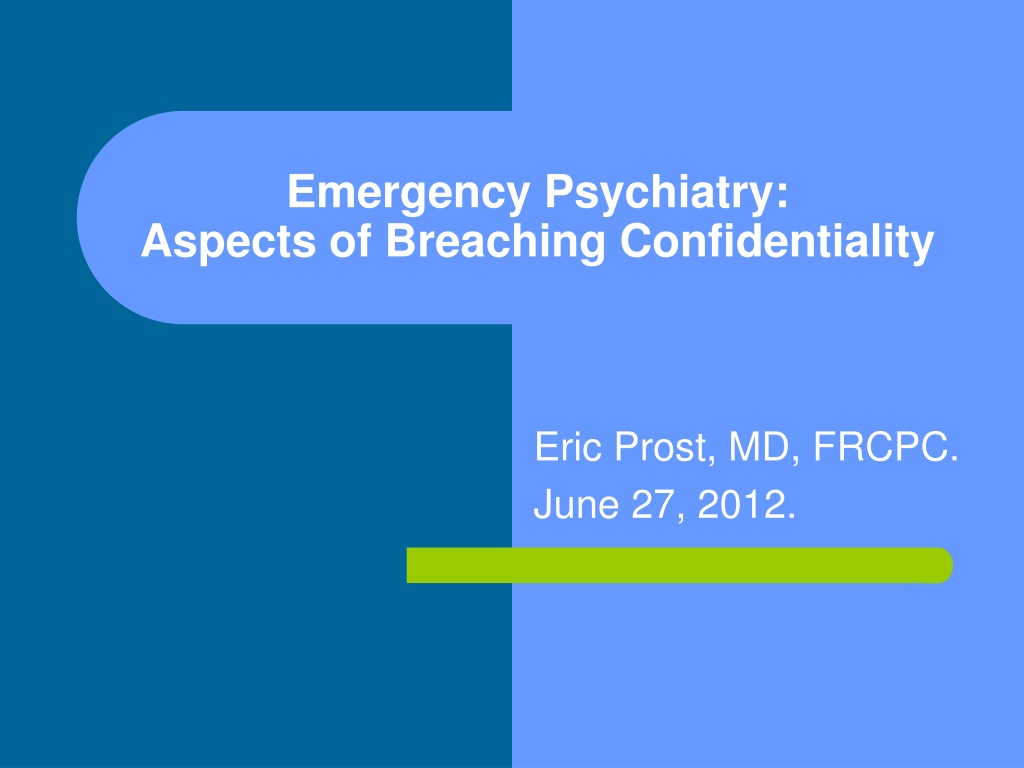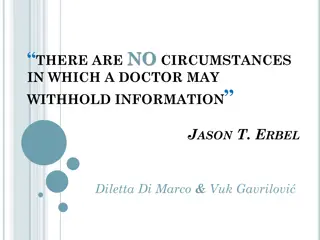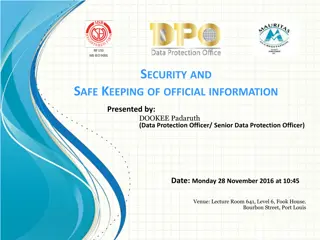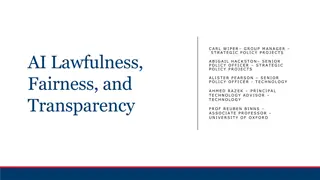Understanding Necessary and Lawful Breaches of Doctor-Patient Confidentiality
Review ethical and legal aspects of breaching doctor-patient confidentiality in emergency psychiatry. Explore scenarios like reporting to child welfare services, notifying authorities of potential risks, and duty to protect under the law.
Uploaded on Oct 04, 2024 | 0 Views
Download Presentation

Please find below an Image/Link to download the presentation.
The content on the website is provided AS IS for your information and personal use only. It may not be sold, licensed, or shared on other websites without obtaining consent from the author. Download presentation by click this link. If you encounter any issues during the download, it is possible that the publisher has removed the file from their server.
E N D
Presentation Transcript
Emergency Psychiatry: Aspects of Breaching Confidentiality Eric Prost, MD, FRCPC. June 27, 2012.
Objectives To review some common necessary and lawful breaches of confidentiality in the ER To consider the ethical and legal basis for breaching in the duty to protect .
Doctor-Patient Confidentiality Calling CAS Notifying MTO Warning potential victims; notifying police Working with an SDM Notifying partner of danger of infectious disease Divulging medical records if court ordered Discussing work with spouse, clergy, lawyer
Doctor-Patient Confidentiality Not Lawyer-Client Privilege Doctor-patient confidentiality is less protected Statutes vs Common Law/Case Law
CAS: Duty to Report CFSA: obligation to report forthwith if you have reasonable grounds to suspect that a child is or may be in need of protection . CFSA supersedes all but lawyer-client privilege Child = <16 y.o. Child = <18 y.o. if a ward or under supervision order of CFSA
CAS Report yourself Report forthwith Ongoing obligation to report A professional who fails to report can be fined Do not investigate yourself Not obligated (or allowed) to give all medical information
MTO: Reporting Highway Traffic Act: doctors must report to the Register of Motor Vehicles those over 16 who are suffering from a medical condition that may make it dangerous for the person to operate a motor vehicle . serious risk to road safety Unknown risk Condition is temporary
Duty to Warn/Protect: Law Tarasoff I (1974), Calif. Tarasoff II (1976), Calif. Wenden v Trickha (1991), AB, Canada Smith v Jones (1999), Supreme, Canada Ewing v Goldstein (2004), Calif. Ahmed v Stefaniu (2006), ON, Canada
Ethical Basis Need vs Privilege Need to preserve life and alleviate suffering Sometimes need extends beyond the individual patient Therefore, doctors should preserve life and alleviate suffering in specific cases of preventable harm Am J Bioethics (2006); 6(2).
Ethical Basis An extension of do no harm to the patient Save him from his actions In therapy, it shows we care enough about the pt and the treatment to set limits on behaviour
Ethical Basis Tarasoff and subsequent developments have reinforced our role as agents for social control Healing Patient Protecting Society (including from those who are not ill) Can J Psych (2000); 45(10).
Statutes 37 states (US) Permissive vs Compulsory Differs by state but common ingredients: Imminence Expressed threat Identifiable victim J Am Acad Psych Law (2010); 38(4).
Canada No statute (no specific legislation) Guided by common law/case law Statutes are clearer and, possibly, more protective
Canada: Common Law Historic: There is no duty to control the conduct of another or warn those at risk. Currently: Above is not true if you have a special relationship with the person inflicting the violence. Can J Psych (2000); 45(10).
Canada: Smith v Jones (1999) If lawyer-client privilege can be breached because of a risk to a 3rdparty, doctor-patient confidentiality can be as well. Supreme Court did not say whether breach is mandatory or discretionary.
Canada: Smith v Jones Did not specify what exact steps an expert might take to protect the public Said it might be appropriate to notify potential victim or the police.
Examples from Statutes (US) Duty present in the law but no duty found in the particular case: No identifiable victim communicated Time elapsed since the treatment No duty because potential victim already knew J Am Acad Psych Law (2010); 38(4).
Canada Identifiable victim (Wenden v Trickha, 1991) Time Elapsed (Ahmed v Stefaniu, 2006) J Am Acad Psych Law (2009); 37(2).
How do you proceed in Canada in 2012? You may need to breach confidentiality to protect a 3rdparty. Duty to warn is but one possible action when discharging your duty to protect. Victim should be identifiable and threat serious, imminent, and likely.
How should you proceed in Canada in 2012? Acting = Law suit? Didn t wait until pt not intoxicated Pt not hospitalized for 72 hrs to fully assess first Notify police? Michigan and S. Carolina study Police have minimal experience with this and, therefore, not best option to protect J Am Acad Psych Law (2003); 31(4) Psychiatr Serv (2000); 51(6)
How should you proceed in Canada in 2012? Open negotiation with the patient in a climate of therapeutic beneficence often results in a solution satisfactory to all parties. Can J Psychiatry (2000); 45(10).























